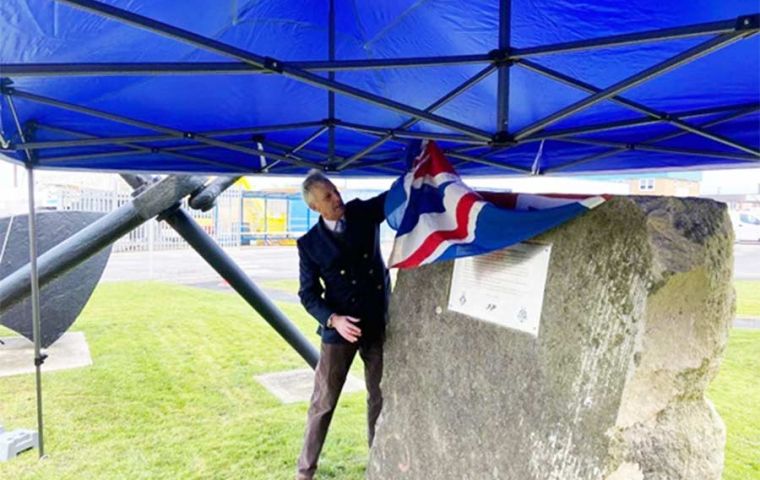MercoPress. South Atlantic News Agency
Falklands Plaque unveiled at Portland to honor dockworkers involved in readying the Task Force
 South Dorset MP Richard Drax, unveils the plaque commemorating the work carried out by dockworkers over a few dramatic weeks in 1982 to liberate Falklands
South Dorset MP Richard Drax, unveils the plaque commemorating the work carried out by dockworkers over a few dramatic weeks in 1982 to liberate Falklands A Falklands Memorial Plaque was unveiled at Portland Port by South Dorset MP Richard Drax, commemorating the work carried out by dockyard employees over a few dramatic weeks in the spring of 1982.
At the outbreak of the conflict Portland’s facilities where in constant demand. The first vessel to depart the UK ahead of the Operation Corporate Task Force was RMAS Typhoon, an ocean-going tug, which head south on April 4 1982 – just two days after the Argentine invasion.
The Task Force would begin leaving the next day, while a second wave underwent a reduced two-week Flag Officer Sea Training (FOST) package in Portland before heading off to join them.
Helicopters at Portland’s Naval Air Station, HMS Osprey were prepared for the arduous 8,000-mile journey to the South Atlantic while across the dockyard the workforce worked tirelessly ashore and on the water, at very short notice, to ready the ships for war; their efforts contributed hugely towards the ultimate liberation of the Falkland Islands.
“Ships were turned around in a very short space of time, what would have normally taken one or two weeks, were operational in one or two days – quite a remarkable feat by any standards,” Mr. Drax said in praise of the team from 1982.
Among those present at the dedication was Paul Charles… in 1982 the youngest crewman of RMAS Typhoon.
“Our destination was unknown when we set off, everyone thought RMAS Typhoon would be turned around as we headed down the Channel – we believed the Argentines would have second thoughts when they saw our ships leaving port.
“But we sailed further and further south, eventually arriving at Ascension Island, we were on our own, then other warships started to arrive.
“Typhoon was very seaworthy, she was an Ocean-going Tug she was built for Sea, she was a beautiful looking ship and had beautiful lines, she was like a greyhound.
“We headed for Tristan da Cunha but no sooner had we dropped anchor, the skipper called out to pick it up again, we were heading for South Georgia, where we were used as a troop carrier, ferrying Welsh Guards from QE2 to Canberra and Norland, for onward transit to the Falklands.”
Mr Charles said the new monument was “a fitting reminder of all those who fought and were part of the effort”.
He continued: “It's not necessarily for me, it's for the people who are no longer with us. There's a lot that have gone now, its recognition of what they did, turning all those ships around in such a short space of time was absolutely incredible, you've got to take your hat off to them.
“A lot of the workers were not remembered, and it's rightly so that the fighting men should get the glory, but the dockyard workers have been remembered by this memorial.”
Another attendee was Leading Cadet Jacob Loveless from Portland’s TS Penn. An apprentice in the Port, he is training to become a Maritime Officer and wants one day to become a tug captain.
“Working in Portland with the tugs gives you an understanding of what those during 1982 went through,” he said.
“This memorial is recognition of the hard work by the workers, in particular tug crews who played a small part with their mighty machines.”




Top Comments
Disclaimer & comment rulesCommenting for this story is now closed.
If you have a Facebook account, become a fan and comment on our Facebook Page!